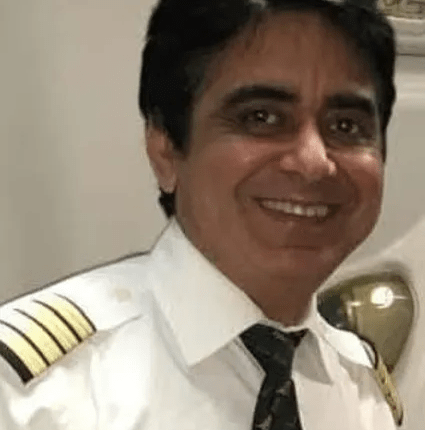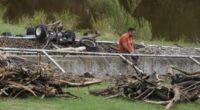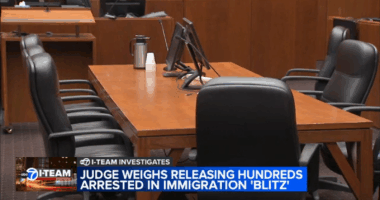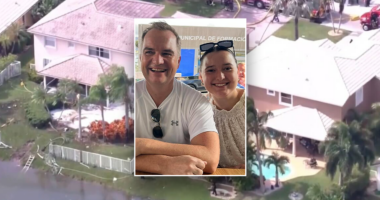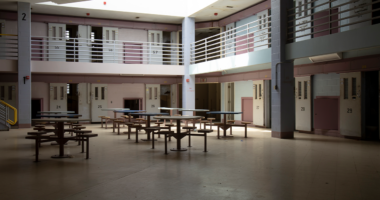Share this @internewscast.com
THE doomed Air India flight’s captain was considering quitting his job early after his mum’s death, his neighbours have revealed.
The London Gatwick-bound AI 171 flight was led by Captain Sumeet Sabharwal, who was reportedly just months away from retirement.
He was planning to retire early so he could care for his 92-year-old father, Pushkaraj Sabharwal, a former official in Indian civil aviation who found himself alone after his wife’s passing.
Savitri Budhania, who lives close to Captain Sabharwal’s house, said she once told him that “your father is too old to be living alone”.
To which the pilot replied: “Just one or two more flights… then I’m going to just be with Papa.”
Ms Budhania told the Times of India that Captain Sabharwal was a gentleman who would often take his father out for evening walks.
She added: “Whenever he wasn’t flying, you’d find him walking hand in hand with his father in the evening.
“They would smile at everyone, just wonderful people.
“Who knew this would be it.”
However, a prominent aviation expert in India informed The Telegraph that Captain Sabharwal struggled with mental health challenges and depression, having taken breaks from work in recent years after his mother’s death.
Captain Mohan Ranganathan, who previously instructed pilots on the Boeing 737, remarked, “Many pilots at Air India have mentioned to me that he was dealing with depression and mental health concerns.”
“He had taken time off from flying in the last three to four years.”
Although Mr Ranganathan added that Captain Sabharwal “must have been medically cleared by the company [Air India] doctors” before flying.
The Air India pilot, 56, is understood to have taken a Class I medical exam on September 5 last year.
Investigators are now said to be probing his medical records after the preliminary crash report indicated there may have been human error, although some aviation experts claim it is a case of deliberate action.
Sources said the black box analysis has so far been unable to rule out “improper, inadvertent or intentional” action that caused them to be flipped.
Families of the victims who tragically died in the crash have slammed the preliminary report as a cover-up.
They have dubbed the investigation “biased” and said it only appears to “blame the dead pilots”.
Key findings of the report:
- Dual engine shutdown – fuel cutoff switches moved from ‘RUN’ to ‘CUTOFF’
- Confusion between pilots – cockpit audio confirms one pilot asked ‘why did you cutoff’, the other replied ‘I didn’t’
- RAT deployed – as seen in CCTV footage before the crash
- Engine relight attempted – fuel switches were found returned to the “RUN” at crash site
- 32 seconds – the time the aircraft was airborne before it crashed
- Thrust levers mismatch – Thrust levers found at idle but black box data shows takeoff thrust was still engaged
- Fuel test pass – fuel was clean without any contamination
- Normal take-off set-up – Flaps and landing gear correctly configured
- No bird activity – clear skies, good visibility, light winds
- Pilot credentials clear – both medically fit and rested
- No sabotage detected – although FAA alerted over a known fuel switch vulnerability not checked by Air India
- Aircraft loading – the flight was within weight and balance limits
The Airline Pilots’ Association of India (APAI) rejected the “tone and direction” of the inquiry and said it came without sufficient evidence.
However, India’s Civil Aviation Minister Ram Mohan Naidu Kinjarapu said that investigators probed in a “mature, transparent” way.
“This is a preliminary report. We want the final report to come in, so let us wait for it,” he added.
Early findings in the 15-page report released by the Indian authorities indicate switches to the engines’ fuel supplies were moved from the “RUN” position to “CUTOFF”.
The fuel switches were then toggled to the “RUN” position, and the engines appeared to be gathering power, but failed to stop the plane from decelerating.
Analysis of the cockpit voice recording revealed that one of the pilots asked: “Why did you cut off?”
To which the other pilot replied: “I didn’t.”
Though the report does not identify which comments were made by the flight’s captain and which were made by the first officer.
Nor does it “identify the cause – whether it was crew error, mechanical malfunction, or electronic failure.”
It is almost impossible to turn the switches off accidentally – they must be pulled up and locked before flipping – a safety design feature that was introduced decades ago.
Protective guards are further installed to minimise the risks – raising further questions as to why the fuel switches in the Air India flight were turned off.
The report points out that the US Federal Aviation Administration (FAA) in 2018 issued a Special Airworthiness Information Bulletin (SAIB) – highlighting that a few Boeing 737 fuel control switches were installed with the locking feature disengaged.
But it was not deemed unsafe, and no Airworthiness Directive (AD) – a legally enforceable regulation to correct unsafe conditions in a product – was issued.
A similar switch design is used in Boeing 787-8 aircraft, including Air India’s VT-ANB Dreamliner in question.
The FAA and Boeing have now privately issued notifications that the fuel switch locks on Boeing planes are safe, according to four sources and a document seen by Reuters.
The report said Air India had said it had not carried out the FAA’s suggested inspections, as the FAA 2018 advisory was not a legal mandate.
But it also said maintenance records showed that the throttle control module, which includes the fuel switches, was replaced in 2019 and 2023 on the plane involved in the crash.
The Boeing 787 Dreamliner with 242 passengers on board – including 53 Brits – smashed into a doctors’ hostel in Ahmedabad in the west of India.
The plane was headed to London Gatwick when it crashed just seconds after take-off, killing all but one passenger.
